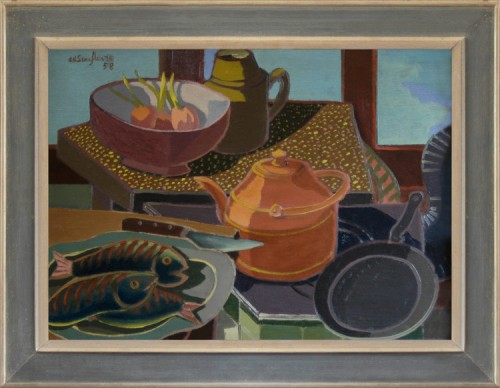Painted near the end of Scauflaire’s life, when he was 65, this work is firmly in the mainstream of his output, both technically and stylistically. The assembly of domestic objects seen at close range within a suggested interior, the earthy colours, the varying perspectives within the arrangement, and most of all the acute sense of pattern, are present in works such as Nature morte aux gants (1919?), Bouquet dans un vase (1920), Nature morte au gateau, and Still life with three oranges (1953). All these convey a confidence in his ability to translate a three-dimensional group of objects into a flat decorative surface, where harmony of colour reconciles the tensions of an ambivalent space. The current work, with its extremely subtle and unified colour range, is a particularly sophisticated development of Scauflaire’s vision.
Biographical details
Edgar Scauflaire (1893-1960) was born in Liége, and studied at the Académie des Beaux-Arts there, under teachers such as Auguste Donnay, Adrien de Witte, Francois Maréchal and Emile Berchmans. He came under the influence of Picasso and Braque; his nudes have a strong similarity to Picasso’s monumental nudes of the 1920s, whilst his still life paintings are related to those of Braque. However, his work never degenerates into copying nor pastiche; and his pastels have a particular charm in their technique and colouring. As well as paintings, pastels and murals, he produced tapestries, frescoes and paintings on glass; he also created artwork for posters, such as that for the 1939 Expo Universelle in Liége.
In 1948 he exhibited work at the Salon d’Art Moderne et Contemporain in Liége which was greatly praised. He showed at the Biennials in Venice (1924, 1938, 1948), those of Sao Paolo (1951 & 1953), and Menton (1953), as well as the Salon des Tuilleries and the 1958 Exposition Universelle in Brussels. He was awarded the Prix de l’Association Industrielle de Santa-Margarita Ligure, and helped to found L’Association pour les Progrès Intellectuels et Artistique de la Wallonie.
His work is in the collections of the Belgian State, and the museums of Liége, Verviers and Brussels, Strasbourg and Buenos Aires.


